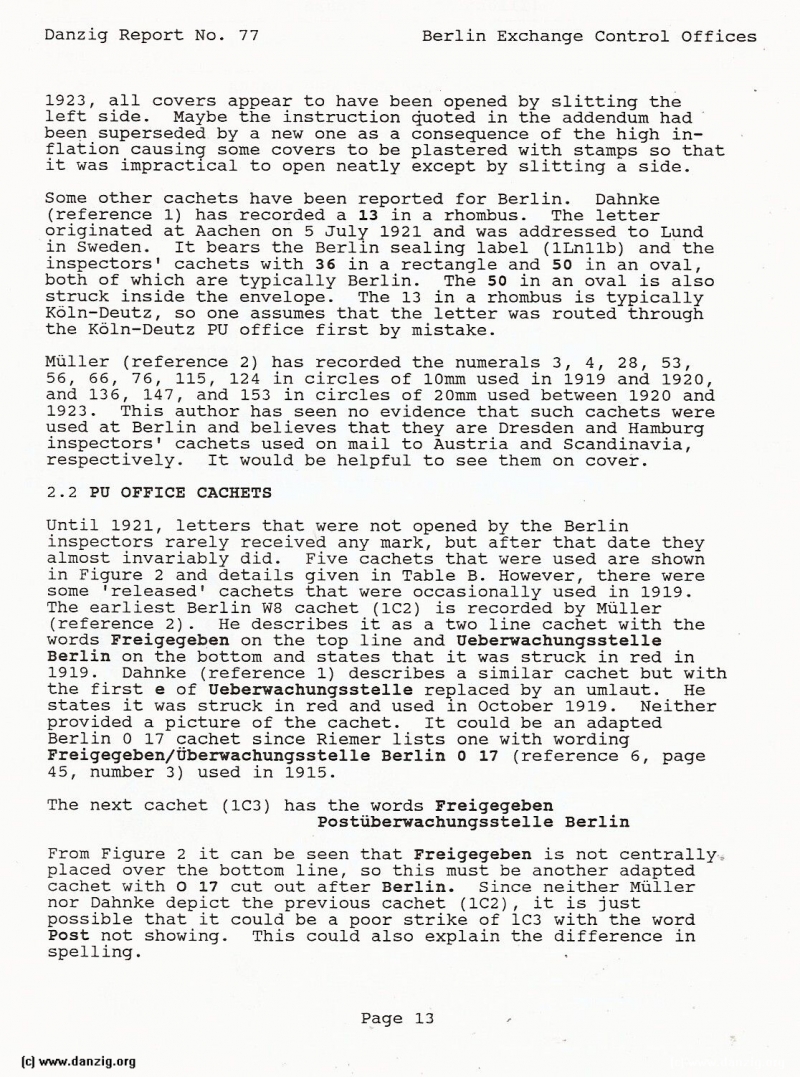
1923, all covers appear to have been opened by slitting the left side. Maybe the instruction cuoted in the addendum had been superseded by a new one as a consequence of the high inf lation causin some covers to be plastered with stamps so that it was impractical to open neatly except by slitting a side.
Some other cachets have been reported for Berlin. Dahnke (reference 1) has recorded a 13 in a rhombus. The letter originated at Aachen on 5 July 1921 and was addressed to Lund in Sweden. It bears the Berlin sealing label (lLnllb) and the inspectors’ cachets with 36 in a rectangle and 50 in an oval, both of which are typically Berlin. The 50 in an oval is also struck inside the envelope. The 13 in a rhombus is typically Köln—Deutz, so one assumes that the letter was routed through the Käln-Deutz PU office first by mistake.
Muller (reference 2) has recorded the numerals 3, 4, 28, 53, 56, 66, 76, 115, 124 in circles of 10mm used in 1919 and 1920, and 136, 147, and 153 in circles of 20mm used between 1920 and 1923. This author has seen no evidence that such cachets were used at Berlin and believes that they are Dresden and Hamburg inspectors’ cachets used on mail to Austria and Scandinavia, respectively. It would be helpful to see them on cover.
2.2 PU OFFICE CACHETS
Until 1921, letters that were not opened by the Berlin inspectors rarely received any mark, but after that date they almost invariably did. Five cachets that were used are shown in Figure 2 and details given in Table B. However, there were some ‘released’ cachets that were occasionally used in 1919. The earliest Berlin W8 cachet (lC2) is recorded by Muller (reference 2). He describes it as a two line cachet with the words Freigegeben on the top line and Ueberwachungsstelle Berlin on the bottom and states that it was struck in red in 1919. Dahnke (reference 1) describes a similar cachet but with the first e of Ueberwachungsstelle re1aced by an umlaut. He states it was struck in red and used in October 1919. Neither provided a picture of the cachet. It could be an adapted Berlin 0 17 cachet since Riemer lists one with wording Freigegeben/Uberwachungsstelle Berlin 0 17 (reference 6, page 45, number 3) used in 1915.
The next cachet (1C3) has the words Freigegeben Postüberwachungsstelle Berlin
From Figure 2 it can be seen that Freigegeben is not centrally: placed over the bottom line, so this must be another adapted cachet with 0 17 cut out after Berlin. Since neither Muller nor Dahnke depict the previous cachet (1C2), it is just possible that it could be a poor strike of 1C3 with the word Post not showing. This could also explain the difference in spelling.
Danzig Report Vol. 1 - Nr. 77 - October - November - December - 1992, Page 13.
Hits: 3904
Added: 03/07/2015
Copyright: 2025 Danzig.org

